These are my notes from the Jan. 2016 ClickerExpo clicker training conference. They were originally published on my business site, DogTrainingology.
![]()
In January 2016, I visited Reno for several days to attend ClickerExpo, one of the largest gatherings of clicker trainers and positive animal trainers. The event, which is held three times a year (twice in the States and once in Europe), is organized by Karen Pryor Clicker Training.
And, I decided to try something new this year at ClickerExpo.
I shared live updates throughout the weekend with quotes from the conference and some of my notes and thoughts from the presentations, as well as plenty of photos. If you’ve never been to ClickerExpo (and even if you have), I hope you’ll enjoy experiencing ClickerExpo as you read these notes.

01/21 01:00 All packed
I’m all packed and it’s way past time for bed…
I have to be up in less than six hours to head to the airport to catch my flight to Reno.
I’m pretty excited because I know this is going to be such a fun weekend!
If you’re also going to be at the expo this weekend, leave a comment on this post or shoot me an email so that we can connect. I would love to meet you!
The picture below will give you a taste of some of the fun little things I packed to bring with me…. Several hundred colorful plastic buttons, toy animals and cars, and more.
They’re for our PORTL lab on Sunday. More about this later on!
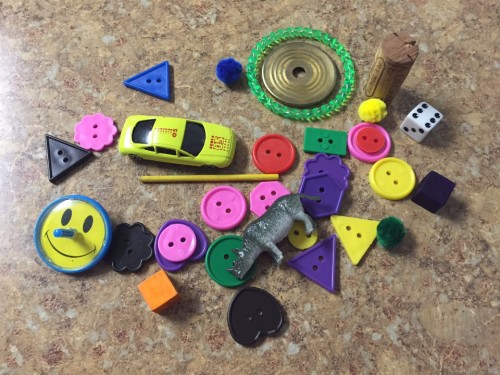
01/21 09:10 And we’re off!

01/21 16:25 O suitcase, where art thou?
Jesús and I made it safely from Dallas to Reno.
My poor suitcase, however, seems to still be in Dallas. Hopefully, it will join me soon!
(The airline assured me that it should arrive this evening. So, fingers crossed.)
I’m looking forward to the opening reception tonight…. More updates soon!

01/22 11:32 And it begins!
I’m at the opening session, which is being led by Aaron Clayton and Ken Ramirez.
As you will see from the picture below, the room is full! I think there are about 500 people here this year.
Aaron is explaining ClickerExpo’s unique system of raffle tickets. Here’s how it works:
1. Each attendee is given a handful of tickets.
2. When you get your tickets, you can go ahead and write your name on them. However, you can’t turn them in for the raffle (yet).
3. Throughout the Expo, you can “tag” other attendees by giving them a ticket when you see them doing something helpful. This can be for just about anything – if someone gives you directions, or introduces themselves to you and makes you feel welcome, if you notice someone taking great care of their dog, or just about anything you notice where someone is being friendly or helpful.
4. Once you “tag” someone and give them a ticket, they then get to add their name and info to the back of the ticket as well.
5. Finally, the other person turns in the raffle ticket with both your info and their info on the back of it!
P.S. For those following along from yesterday, my suitcase did show up very late last night!


01/22 12:00 Can any animal be trained?
Ken Ramirez is talking about a project he did last summer in the UK. It involved training about 10,000 butterflies to fly on cue from one point to another over a distance of about 1,000 meters.
Not only was Ken able to do this, he was able to do it in under three weeks!
The project involved dividing the butterflies into three different groups (based on species and color). Each group had their own cue, so that the trainers could signal each group individually.
The final performance involved having the butterflies fly back and forth over an orchestra at a large gala. The event was organized to raise money for conservation, and it was able to raise over 1.4 million dollars!
Most people who have not heard this story would more than likely tell you that butterflies can’t be trained.
However, with positive reinforcement training techniques, patience, and a well-designed training plan, butterflies (and ANY other kind of animal) can be trained!

01/22 12:45 High precision
Hannah Branigan is beginning her talk on “High precision, high scores.” I think this is going to be good!
Some trainers will say – training for precision is boring.
Hannah says “Precision is not boring!”
We want precise behaviors, but performed with lots of enthusiasm. We don’t have to make a choice between precision and enthusiasm. We can train for both, and clicker training is the perfect technology for us to do this.

01/22 13:58 The cutie sitting next to me in Hannah’s talk
This little guy was such a cutie and so sweet! He came over and said “hi” to me and enjoyed getting some petting and scratches.

01/22 14:15 Notes from Hannah Branigan’s talk on “High Precision”
Here are a few quick thoughts and notes from Hannah Branigan’s talk on training precision. Loved this talk – Hannah is great at analyzing and explaining the tiny details that make the difference between an okay behavior and an awesome behavior.
1) When we train for precision, we have to know exactly how the behavior breaks down. What muscle movements should the dog be doing when he does the behavior? Spend time studying examples of what you think the “perfect” behavior should look like.
2) Some trainers say that you can’t get very precisely trained behaviors without using punishment. This is certainly not true! You don’t need punishment to train high precision. Precision has everything to do with the criteria you set. Focus on well-defined goals, clear criteria, and constructing a solid plan.
3) High precision has to do with biomechanics. It is helpful to look at and understand the intersection between training, conditioning, and medicine.
4) What size of behavior are you looking at? We often think of “sit” as a single behavior. Or, we could look at it as a dozen (or more) little individual behaviors that happen one after another, that add up to make the sit.
5) Hannah analyzed in detail the behaviors of sit, down, and stand. She showed some really nice slow-motion videos of dogs doing these behaviors. We were able to see different versions of the behavior and focus on the different types of movement and the different muscles that the dog was using. It was really interesting to watch!
6) Behaviors matter even if you don’t think they matter…. In many dog sports, the precision of the “stand” position isn’t really evaluated, as long as the dog stands on cue and holds the position. However, if the dog is poorly balanced in the stand, this will definitely influence how the dog will be able to perform whatever behavior follows.
7) Often, if there’s a problem with one behavior (the dog does the movement incorrectly), the dog is using the wrong groups of muscles and you’ll see issues with other behaviors as well. But, what this also means is that if you fix it in the right way, it will often help the other behaviors improve, too.
If you found this interesting and are wanting to learn more about how to focus on specific movements during shaping, check out this blog post I wrote last fall for The Art and Science of Animal Training. http://www.artandscienceofanimaltraining.org/concepts/shaping-movement-cycles/
01/22 16:11 The Power of Silence
Michele Pouliot is talking about “The power of silence: Accessing the power of a withheld click.”

01/22 17:19 A few notes from The Power of Silence with Michele Pouliot
Michele Pouliot talked all about the silence of no click. What does it mean to the dog when we withhold the click? How and why should we use this in our training?
This presentation involved a LOT of video clips. I wish I could share them with you, because Michele used the videos to help illustrate and explain the concepts she discussed.
This presentation was all about shaping and how and when a trainer should decide to raise (or lower) criteria. There is often quite an art to this! Michele has studied this process in detail and shared many wonderful examples and insights. Here are a few of my thoughts and notes from the presentation:
1) During training, a withheld click is information. If you withhold the click, it should prompt the dog to increase or vary the behavior. Then, when you do “click,” it communicates to the dog what new behavior works.
2) Trainers often use withheld clicks ineffectively. This can lead to the dog offering lots of known behaviors, frantically offering behavior, frustration, a diminished desire for the dog to keep trying, and eventually the dog giving up.
3) You have to build a sufficient history of reinforcement with a behavior, before you can use withheld clicks to improve the behavior. You need to have a clean “loop” of behavior (behavior –> click –> reward –> dog offers the behavior again). The “loop” of behavior shouldn’t have any extra or unwanted behaviors. (More info in this blog post about “loopy” training.)
4) If you don’t have a “clean” loop and the dog is offering lots of extra behaviors, lower your criteria! This will help the dog catch on a lot faster then if you just keep trying to train at your current level.
5) It’s hard to always raise and lower criteria at the ideal moments! Most trainers either tend to raise criteria too fast or remain at the same criteria too long. Which are you? If you know your tendency, then you can watch out for it during training.
6) Before you use withheld clicks to improve the behavior – you should have a plan! Anticipate what new or different behaviors the dog might offer. Know what change you are hoping for. This will help you so that you are ready to click when the dog does offer a specific new behavior.
7) Be careful about staying on one training step for too long. The dog can get stuck on the behavior, and it will become harder to modify this behavior later on.
01/22 18:01 Mary Hunter meets Mary Hunter
There is another woman at the conference who is also named Mary Hunter! She’s a dog trainer from Idaho. Our names caused some confusion at registration….
We finally got to meet up this afternoon. 🙂

01/22 18:48 Find it!
I went to a lab session this afternoon that was taught by Sarah Owings. The session was titled “Find it! Activating the seeking system.”
In the lab, Sarah talked about games and activities that you can play with your dog that involve searching, hunting, and problem-solving skills. These types of activities all activate the dog’s SEEKING system, by releasing dopamine in the brain. In addition, they provide lots of enrichment and are lots of fun!
There are many informal games that you can play with your dog that involve searching for things – such as getting to sniff around the park on a long leash or getting to dig around and find treats that have been hidden in a rolled up blanket.
There are also what Sarah calls formal Find It games.
Formal Find It games involve three components – a search, a locate, and a report. Sarah suggested that it can often be easier to teach each component separately, then combine them together.
Sarah showed some video examples of her own dogs playing formal Find It games. For example in one video, one of her dogs has been trained to search the house for Sarah’s house shoes and then bark when the shoes are found!
In the lab, participants worked on some of the component skills to teach Find It games. The first several activities included:
— Working on targeting with the target on the ground
— A “pendulum” search game where the person kneeled on the floor and placed the target on either side. The dog had to very briefly search for the target. The target was switched from side to side and was gradually shifted until it was behind the person.
— A back-chained indication. Participants began to teach their dogs how to locate a target and then offer a certain behavior (sit, down, etc.) upon reaching the target.

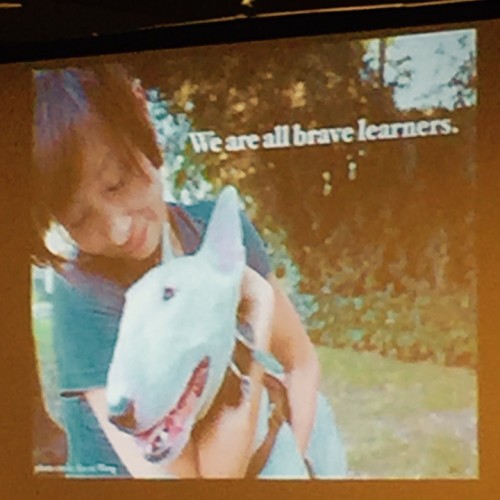

01/22 19:10 Rates of reinforcement
Now I’m listening to Dr. Jesús Rosales-Ruiz talk about high rates of reinforcement. The room is packed!
Trainers often say that you need high rates of reinforcement when training behaviors. But what does this really mean? How do we achieve high rates?
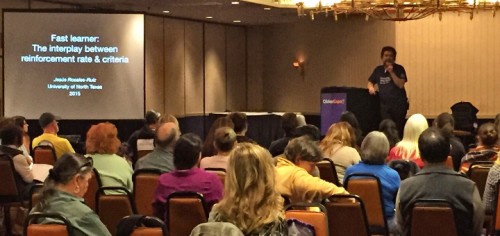
01/22 19:57 Notes from “Fast learner” with Dr. Jesús Rosales-Ruiz
Dr. Rosales-Ruiz discussed several strategies that lead to a higher rate of reinforcement.
When training isn’t going well, trainers often recommend increasing the rate of reinforcement. However, Dr. Rosales-Ruiz argued that this is a red herring and the wrong thing to be looking at. This is because the rate of reinforcement is an outcome of the shaping process, rather than something we can change directly. So, what trainers really need to be looking at is the shaping process and what changes they can make during shaping that will lead to higher rates of reinforcement.
1) You can achieve higher rates of reinforcement by adjusting the shaping criteria. Dr. Rosales discussed behavior loops and behavior cycles. Do you have a clean “loop” of behavior? This means no extra behavior or unwanted behavior. If your criteria is too high, you won’t have a clean loop and you will probably also end up with a low rate of reinforcement as a result.
2) You can achieve high rates by adding opportunities to perform short, easy behaviors. This is especially helpful when you are working on a really difficult behavior. How this works — do several repetitions of the behavior you are working on. Then, give a cue and switch to a very easy behavior that the animal knows well and will be able to do readily. Do a few reps of this behavior, then return to working on the hard behavior.
There are two other ways to increase the rate of reinforcement – by focusing on reinforcing outcomes and by using lots of clicks and treats to distract the dog from something else in the environment. However, Dr. Rosales-Ruiz recommended not using these as training techniques because you often don’t know exactly what you are reinforcing and sometimes you can end up reinforcing the wrong behaviors.
01/23 11:17 Now I’m listening to Kathy Sdao talk about cues
It’s the beginning of day two! First lecture of the day, I’m at a talk by Kathy Sdao.
Kathy’s lecture is called: “What a Cue Can Do: Developing Cueing Skills.”
Kathy has just started talking about cues. It’s so important to understand cues and how they work. Our job as trainers is to give clear signals (cues) to our dogs, so that they understand exactly what they should do.
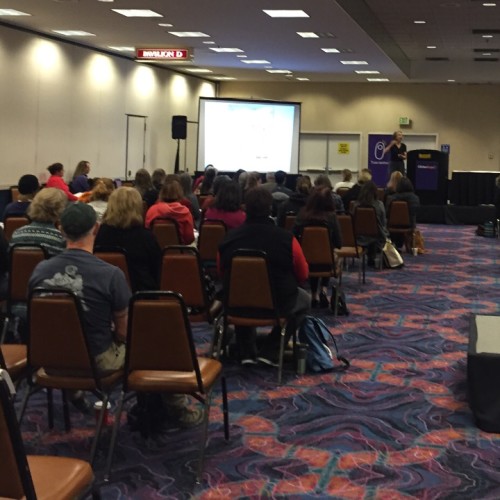
01/23 12:28 A few notes from “What a cue can do” with Kathy Sdao
1) To effectively train an animal, we have to give the animal information about what to do (this comes from the antecedents, that is, the cues) and motivation (which comes from the consequences that follow the behavior).
2) Cues don’t “cause” the animal to do the behavior. Instead. They tell the animal “when” to do the behavior.
3) The word “cue” comes from a Latin word that means “when.” The word was used early on for stage directions for actors. If the actor doesn’t know his lines — repeatedly giving the cue or giving the cue in a louder voice is not going to help him remember his lines! Same thing with training animals — if the animal doesn’t understand the cue, repeatedly giving the cue or using a louder voice isn’t going to teach the dog what to do.
4) Commands and cues are not the same. They both provide information to the animal. However, cues are taught with positive reinforcement and are “green light signals.” Commands are threats that have been taught with aversive consequences – they tell the animal “you better do the behavior, or else.”
5) You can’t tell if a signal is a cue or a command by the way the person says the word or gives the signal. You can only tell by looking at what follows the behavior and by knowing how the behavior was trained.
6) Cues should be salient, distinct, consistent, and simple.
7) Have you every tried to learn a foreign language? Perhaps you listened to a language course on a CD. Were there sections that you had to listen to over and over again, because several of the words sounded very similar and you couldn’t distinguish between them? Dogs don’t speak English and it can be hard for them to distinguish between words that sound very similar. Pick words (and hand signals) as cues that are very distinct from your other cues.
8) If a cue is taught correctly with positive reinforcement, the cue becomes a conditioned reinforcer. This is why behavior chains work – the cue can be used to both signal the next behavior AND to reinforce the previous behavior.
01/23 13:10 Next up: Functional analysis
I’m listening now to Dr. Susan Friedman. Should be an interesting talk!


01/23 14:29 Notes from Dr. Friedman’s talk on functional analysis
Here are just a few quick thoughts from Dr. Susan Friedman’s talk on functional assessment and functional analysis. Such an interesting and important subject!
1) Dr. Friedman began by talking some about the brain and about emotions. She quoted Dr. Jesús Rosales-Ruiz — Every behavior we train has emotions attached. The emotion is in the contingency.
Different contingencies will produce different emotions. For example, extinction tends to produce frustration, positive reinforcement tends to produce happiness and positive emotions.
2) Population-level behavior, that is the average behaviors or normal characteristics of a species or group of animals, doesn’t always help us when we are working with individual animals. Individuals don’t always follow the population norm! The population norm is just an average.
For example, imagine that sea lions, on average, vocalize more and vocalize louder than seals. However, the distribution of behavior of the individuals in each group will probably overlap. At the edges, one very loud seal might actually vocalize more and vocalize louder than the most quiet of the sea lions. When we are interested in training an individual animal and changing that animal’s behavior, we need to study and understand the behavior of that individual, rather than the behavior of the larger population. Behavior analysis gives us methods to do this.
3) Behavior analysis is a natural science approach to studying the relationships between the environment and behavior. Applied behavior analysis is the application of this science to solve practical problems. To solve problems, we change the environmental conditions and redesign the environment so that new skills are learned and so that it is easy for the animal to do the behavior we want.
4) How do we figure out why a particular behavior is happening and what variables and consequences are related to the behavior? Two strategies to consider. Functional assessment: Interview individuals who know the animal best or directly observe the animal in normal conditions over an extended period of time. Functional analysis: Systematically change potential variables and conditions that might control the behavior and observe what happens.
5) Your analysis should focus as much (or more) on the environment as on the behavior.
01/23 16:03
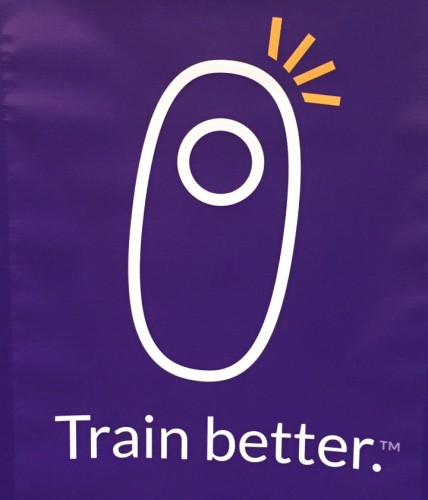
01/23 16:16 Time to talk all about quadrants…..
First talk after lunch. I’m listening to Dr. Jesús Rosales Ruiz talk about the quadrants. The title of his talk is “The quadrant quandary: Clarity and perspective on an icon.”

01/23 17:08 Control is an illusion…
Next talk up – Sarah Owings talking about stimulus control!

01/23 18:36 Notes from Sarah Owing’s talk on stimulus control
Sarah Owings’ talk this afternoon was all about stimulus control. Basically, Sarah was discussing how to teach precise cues so that the animal learns to do the behavior as soon as the cue is given, and the animal doesn’t spend lots of time offering the behavior when the cue hasn’t been given.
Many clicker trainers teach (or used to teach) their students to train cues in the following way:
1) Shape the behavior until the dog is freely offering the behavior you want.
2) Add a cue to the behavior.
3) If the dog offers the behavior when you have not given the cue, do not reinforce the behavior.
This sounds simple enough, but step three can sometimes get pretty complicated. Some dogs will continue for some time to offer the behavior when you have not given the cue. This can lead to quite a bit of frustration!
The point of Sarah’s talk was to give practical strategies and advice to make it easier for trainers to put behavior on cue with minimal frustration for the animal.
Sarah discussed six strategies that trainers can use to teach cues with minimal frustration and minimal extinction. This included anchoring, release cues, clean training, cue slides, click for waiting, and cue roulette.
I’m going to summarize two of these strategies for you:
Click for waiting: This is exactly what it sounds like. When you haven’t given the cue, you click for the dog standing still and patiently waiting for you to give the cue. At first, your clicks might have to be fairly close together, especially if you have a dog that generally likes to offer a lot of behavior. In between periods of clicking for waiting, you can practice giving the new cue. This tells the dog that he doesn’t have to offer lots of behavior, and it reinforces the dog for patiently waiting for the cue.
Cue roulette: In cue roulette, you mix up the cues. The dog never knows which cue you are going to give next, so he has to pay close attention, and he starts to learn to wait for the cue. It also makes it easier when first teaching a cue, because you can mix up the new behavior with behaviors that the dog already knows well. In another variation of cue roulette, you can switch between giving the new cue and saying incorrect or nonsense words. The animal has to listen closely for the correct word.
Sarah ended with several take-home points. One was to remember that stimulus control is all about clear communication. Rather than control, think about communication. For great training, we have to find ways that help us clearly communicate to the animal what behavior we want and when we want the animal to do the behavior.
01/23 18:38 The panel discussion has started!

01/23 19:39 Notes from A quadrant quandary
I didn’t get a chance to post notes earlier from Dr. Jesús Rosales-Ruiz’ talk about quadrants. I’m only going to share a tiny piece of this talk, as there was so much information packed into this talk!!
One of the most interesting things that Dr. Rosales-Ruiz discussed was the relativity of reinforcers.
Many times, we talk about reinforcers as if they were absolutes. For example, a trainer might say “Treats are a reinforcer for my dog.” Or, a trainer might say “Chasing a ball is more reinforcing than eating kibble, for my dog.”
However, the point that Dr. Rosales-Ruiz explained in his talk was that we can’t say that something is always and absolutely a reinforcer. We have to look at the whole context and situation and whether the behavior is increasing before we say that something is a reinforcer.
Dr. Rosales-Ruiz discussed a famous experiment that was done by Dr. David Premack. Premack started out by giving rats free access to both a running wheel and water. The rats would spend some time running on the wheel, some time drinking water, and some time doing other things.
Then, Premack removed the water. However, the rat could earn a drink of water by running on the wheel. What Premack found was that the behavior of wheel running increased. The drink of water reinforced the behavior of running on the wheel.
Later, however, Premack switched things up. The rats had free access to the water, but the wheel was removed. What happened here was that the rats could drink water to gain access to the wheel. Premack saw a huge increase in water drinking. In this situation, the behavior of drinking water was reinforced by the opportunity to run on the wheel.
A similar study has been done with children, using video games and chocolate. In some situations, children would play video games to earn a bite of chocolate. However, other situations were arranged where the children would eat chocolate in order to earn the chance to play the video game.
The take-home point here is that reinforcers are relative. What will function as a reinforcer will be completely dependent on the context and the constraints in the environment.
Think about this too in regard to your own behavior. What is your favorite food? Perhaps it is chocolate cake. But, if you’ve just eaten two huge pieces of chocolate cake, you probably would feel quite full and you wouldn’t want cake anymore. In this context, even though cake is your favorite food, I wouldn’t be able to use it to reinforce your behavior. Instead, if you were really, really full, it might even punish certain of your behaviors if I tried to offer you another piece of cake to eat. (But, I might be able to use something else as a reinforcer, such as money, to get you to eat several more large pieces of cake.)
So, the next time you’re training, don’t assume that something is automatically going to be a reinforcer. Instead, pay attention and see how your animal responds and whether the thing actually is functioning as a reinforcer.
01/23 21:13 Eva Bertilsson hanging out with 14-year-old Brittle

01/23 21:47 At the Saturday night dinner 🙂

01/23 23:26 Notes from Al Kordowski’s talk at the Saturday evening dinner
The speaker at dinner this evening was Al Kordowski. Al’s background was marine mammal training. However, for the past five years, he has been the training director for Service Dogs, Inc., located in Dripping Springs, Texas.
Fun fact: Al Kordowski and Ken Ramirez have known each other for 40 years! They met years ago, since they were both involved in marine mammal training.
Service Dogs, Inc. is a non-profit organization that trains hearing service dogs and mobility service dogs. All of their dogs are pulled from shelters, mainly shelters in Texas and Oklahoma. The dogs are then trained at Service Dog, Inc.’s training facility. It takes about a year to train each dog, and then the dog is paired (for free!) with an adult in Texas who is in need of a service dog.
Al’s talk took us step-by-step through the year-long training process, from evaluating dogs in the shelters, to basic and then more advanced training, to placing each dog with the right individual.
Al also focused on many of the aspects that make the Service Dog, Inc. training program slightly different from other service dog training programs. For example, their training program places a lot of focus on developing strong relationships between each dog and the trainers. Each training session every day begins with a “relationship building” component. In addition, the program is unique because all of the trainers work with all of the different dogs in the program. The program has about 15 dogs in training at a time, but no kennel techs. The trainers are responsible for all of the daily care for the dogs, which means training can be incorporated into all of the interactions the dogs have with people throughout the day.
It was really interesting to hear Al’s talk. And, his presentation was a lot of fun to watch, as it was filled with lots of cute photos and videos of the dogs in his program.
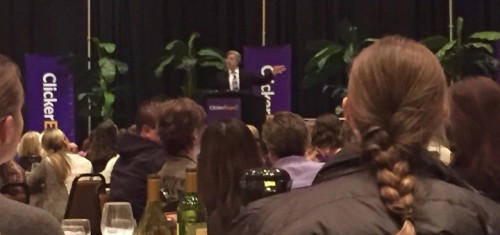
01/24 11:03 Day three begins!
It’s the last day of ClickerExpo. I can’t believe that it’s almost over. We’ve had a wonderful time so far, and I’m looking forward to one more day of great talks.
One of the hardest parts about ClickerExpo is that there is no way to see everything. At each time slot, there are usually four lecture sessions and two lab sessions.
So, you just have to pick!
It can be frustrating sometimes, though, if there are two or three different topics that you want to see, and they are all at the same time slot. Sometimes, you have to plan with a friend and each decide to go to a different talk, and then you can both report back later and share notes.
This is one reason why I often post my conference notes online – I know that even people who went to ClickerExpo probably didn’t go to the exact same talks that I attended. This is also why I enjoy reading other people’s notes from ClickerExpo – I learn things about talks that I wasn’t able to attend.
So, I hope you’ll enjoy following along for one more day of notes!
01/24 11:09 The rat is always right
I’m at my first talk on Sunday – a lecture by Dr. Susan Friedman on errorless learning. This is one of my favorite topics, so I’m looking forward to seeing what Dr. Friedman has to say about it!

01/24 11:28 Another cute pup. 🙂

01/24 12:34 The rat is always right!
How do people and animals learn? Traditionally, learning has been thought of as something that happens because of trial and error. We make mistakes and are sometimes successful. Over time, we learn from our mistakes. The mistakes gradually reduce and the correct responses increase, until we are almost always correct.
However, Skinner (and other behavior analysts) have been concerned with how we can create optimal learning situations. That is, how can we increase the number of correct responses during learning and at the same time decrease the number of incorrect responses and the amount of frustration during shaping. Research on errorless learning by Skinner, Terrace, Sidman, and others has even shown that learning can happen with zero errors!
One of the main points Dr. Friedman discussed in her talk is the notion that “The rat is never wrong.” This Skinner quote gives us a different perspective from how most people approach learning. What Skinner meant by this is that if the rat (or other animal or person) is making a lot of mistakes or is not learning — it is not the rat’s fault!
The rat is just doing what he “thinks” he should be doing, based on the current context and based on what behaviors have been reinforced in the past. So, if the animal is not learning, it is the trainer’s responsibility to evaluate what is going on and make changes to the training program, so that the animal is able to learn easily. Throughout her talk, Dr. Friedman discussed many strategies for how we can design the teaching environment so that we get fast learning with minimal frustration.
01/24 12:40 Teaching dogs the clicker way
During her talk on errorless learning, Dr. Susan Friedman quoted several times from an article called “Teaching dogs the clicker way,” by Dr. Jesús Rosales-Ruiz.
If you have not read this article, you should read it!!
I have a copy of it on my website, and you can find it by following this link. It explains more about errorless learning and other teaching strategies to achieve optimal learning.
http://stalecheerios.com/dog-training/teaching-clicker-way/
01/24 13:09 Come to the bark side!
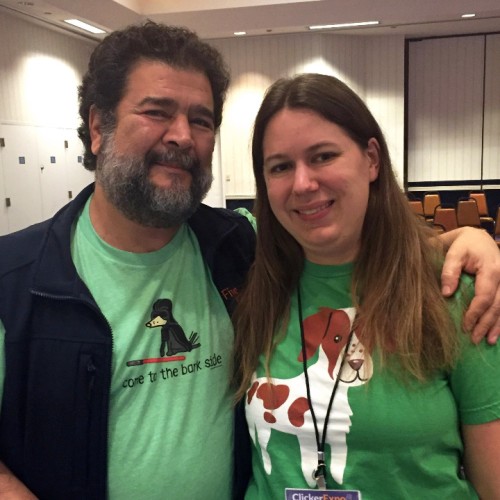
01/24 13:24 Peggy, Eva, and Emelie are about to get started!
I’m really looking forward to this talk — it is titled “Animals in control: The choice is theirs.”

01/24 14:20 Notes from “Animals in Control”
The second lecture I got to hear today was a great presentation by Peggy Hogan, Eva Bertilsson, and Emelie Johnson-Vegh. The presentation was titled “Animals in control,” and it was all about teaching our animals to communicate their wants and needs.
In training, we have to be really careful — are we merely training our animals to endure things or are we also training the animal to be in control during the training? How do we increase communication and choice during our training sessions?
Eva, Emelie, and Peggy explained that choice and control require reliability during training. We have to have a predictable sequence of events. From the animal’s perspective, the animal has to know that in situation A, if the animal does B, then the trainer will follow by doing C.
Incorporating choice and control into training is really important because it helps improve communication and welfare, it allows the animal to communicate his wants and needs, it reduces problem behavior, it allows you to know the animal’s preference, and it teaches us to listen to and respond to our animals.
Eva, Emelie, and Peggy described three different types of choice behaviors that we can use to give our animals more control. This included:
The request – The animal tells us when he wants something.
The choice – The animal picks between two (or more) alternatives.
The start button – The animal directs the pace and tells the trainer when to start / stop.
The best part of this presentation was that it was FULL of lots and lots of wonderful video clips that featured all sorts of different species of animals. This included a dog telling the owner when she wanted to go outside, a parrot indicating which perch he wanted to sit on, a rat asking to get to go play on the floor, a horse telling the trainer when to put on the fly mask, dogs having choice when learning how to go on an agility teeter-totter, a giraffe indicating whether she wanted a scratch or a treat, a dog telling the owner when the water dish was empty, horses indicating whether or not they wanted to wear winter blankets, a parrot telling the owner when to start and stop filing the parrot’s beak, and lots, lots more fascinating examples.
01/24 18:28 Game On!
This afternoon, Dr. Jesús Rosales-Ruiz and I led a two-hour lab where participants got to play the shaping game PORTL. Everyone had a blast! We practiced mechanical skills, then the participants got the chance to practice shaping some different behaviors.
If you’re not familiar with PORTL, check out this article for an in-depth introduction:
http://www.artandscienceofanimaltraining.org/tools/portl-shaping-game/




01/24 18:32 Time for the closing ceremony!
I can’t believe ClickerExpo is already over!
It has been a fantastic weekend, and I hope you’ve enjoyed all the notes.
Right now, we’re listening to the closing ceremony, and Al Kordowski is about to give the closing talk.

01/24 19:20 Rugby!
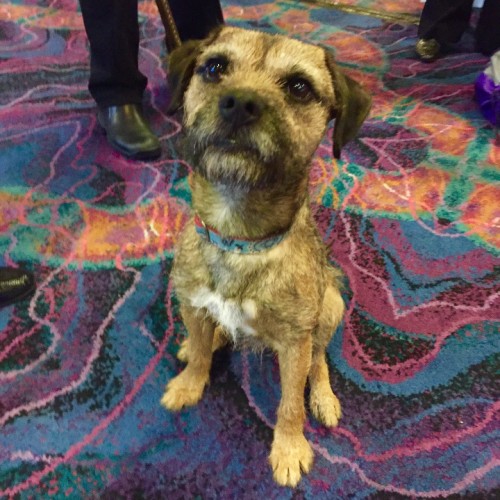
01/24 19:29 Dr. Jesús Rosales-Ruiz and Hannah Branigan 🙂

01/25 14:10 Goodbye Reno!

01/25 21:07 Next up….
We had a fabulous weekend this weekend at ClickerExpo! It was a whirlwind of a weekend, and I had a great time getting to see all of the lectures and getting to meet so many wonderful people.
I’ll be heading in March to the Cincinnati ClickerExpo. If you’ll be there, let me know! I would love to get to meet you. If you’re interested in more information about the March Expo, check out the ClickerExpo website. (www.clickerexpo.com)
Next up, though, I’ll be heading to The Art and Science of Animal Training Conference in Dallas, Texas. This will be our eighth annual conference and the first time that the conference will be two full days! The conference will be February 20-21. There are still some spots available, and I would love it if you could join us. It is a smaller conference than ClickerExpo, and it is definitely a one-of-a-kind event. I’m looking forward to two fantastic days of presentations and discussions!
http://www.artandscienceofanimaltraining.org

